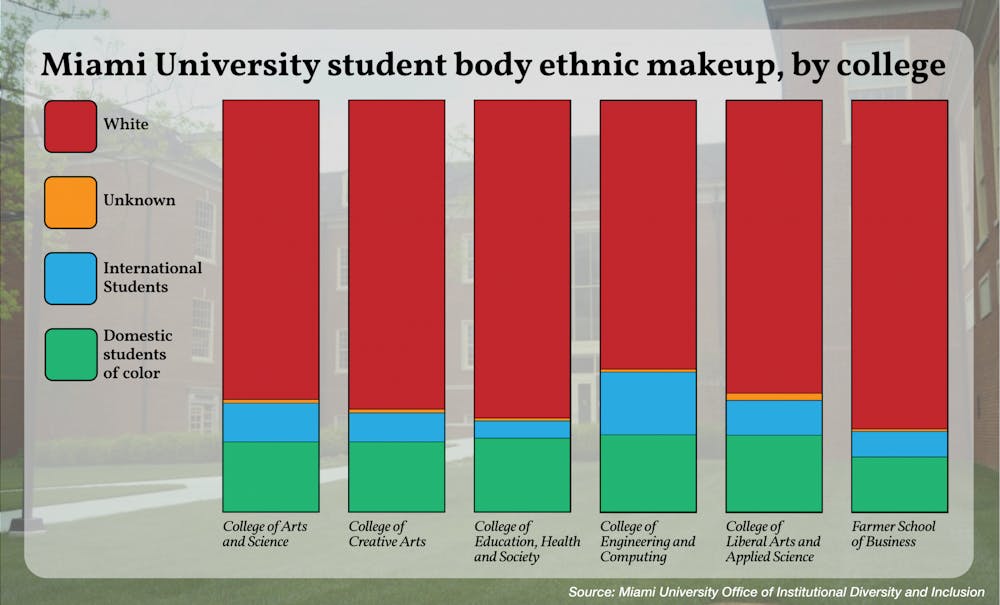The demographics of Miami University as an institution and its five academic colleges are not equal. Some academic colleges include more unequal gender demographics, and some include more or less students of color.
According to Miami University’s enrollment statistics for 2019, 15.7% of its Oxford campus students are domestic students of color while 8.8% are international students, and 51% of students are women.
Grace Trippiedi is an engineering management and mechanical engineering double major and president of Miami’s Society of Women Engineers (SWE). She said she’s one of the few women in her majors.
“I’ve typically been one of five girls [in class],” Trippiedi said. “Sometimes, girls will get called out more just because there’s not as many of them.”
According to Miami’s Data, Reports and Demographics website, only 27.78% of students in the College of Engineering and Computing (CEC) are women.
During her time at Miami, Trippiedi has never had a female professor in her major classes.
“It’s really hard to see yourself succeeding in a hard field where you don’t have any role models that look like you or think like you,” Trippiedi said. “Getting a lot of positive female role models in the college would be really helpful.”
Clark Kelly, assistant vice president for external affairs and communications in CEC, said even within the college, gender diversity varies across majors. In mechanical and computer engineering, only 13% of students are women, while 42% of chemical, paper and biomedical engineering majors are women.
Kelly said research has shown that men tend to choose majors that emphasize power and status while women pick majors that are more community oriented.
“When you look at where the women go into our degrees, it’s into engineering degrees that have communal ties to them, so biomedical engineering or environmental engineering,” Kelly said. “[Other types of] engineering and computer science as a career path have done a very poor job explaining that engineering is about helping people.”
To balance CEC’s student population, Kelly said administration focuses their efforts on diverse recruitment across genders, socioeconomic backgrounds, race and other identities.
“If we’re just encouraging white males to go in, we are losing out on more than 50% of the workforce, and that’s idiotic,” Kelly said. “There has to be changes to … the way we explain what engineering and computing is so that that middle school African American female can see herself in that career.”
Enjoy what you're reading?
Signup for our newsletter
In the Farmer School of Business (FSB), diversity recruitment is important as well.
In 2019, 38.32% of Farmer students were female and 79.87% were white. Farmer had the highest proportion of white students of any academic college at Miami.
Michelle Thomas, director of student organizations and diversity in FSB, said the college holds multiple events over the summer to encourage high school students from various backgrounds to consider careers in business.
“My lane … is to make sure that we’re recruiting and retaining our top diverse students,” Thomas said. “We make sure that we’re building pipeline initiatives at the high schools in Cincinnati, Cleveland, Columbus and out of state as well. We do this by having exposure types of events such as camps in the summer.”
Once students make it into Farmer, Thomas said the focus switches to education about diversity.
Students complete the First Year Integrated Core, an eight credit-hour program that teaches students how to work in diverse groups, during their first two semesters at Miami. In addition, students have to take at least one course centered on diversity.
Rather than focusing on teaching underrepresented students how to survive in industries traditionally dominated by white men, Thomas said it’s important to teach white men how to navigate spaces with diverse people.
“White males, and white students in general, need to be comfortable networking and working with students of color and LGBTQ+ students,” Thomas said. “Instead of putting the responsibility on our underrepresented students, we flip the script. We’re trying to train our white students to be culturally competent.”
Ellie Krug is a senior double majoring in marketing and fashion. She said her courses in FSB made a point to touch on diversity, but in the College of Creative Arts (CCA), it was rarely a conversation topic.
“Farmer talks about diversity so much more than the College of Creative Arts,” Krug said. “I’ve never heard diversity mentioned — [CCA] just inherently is more diverse … Educationally, I learned way more about diversity through Farmer, and I’ve experienced more diversity through the College of Creative Arts.”
Krug said marketing is one of the most balanced majors within Farmer in terms of gender. Prior to this year, she said she hadn’t felt any bias against her in classes. That changed in her capstone course where she was the only woman out of six students.
“There have been times where I feel like I haven’t been taken seriously,” Krug said. “At the beginning of the semester, we’d start talking, and I would chime in and feel like I would just be ignored.”
In Krug’s fashion classes within CCA, she said students come from more diverse backgrounds than in Farmer. CCA’s student body is 61.28% female, while 17% are domestic students of color and 7% are international students.
While CCA allowed Krug to experience diversity, she said she wishes they touched on more diverse perspectives in curriculum and conversations.
“It would be really neat to learn about the diversity of fashion and different cultural backgrounds, or maybe create a class about world fashion or how different people interpret fashion,” Krug said.
When asked for comment, Dean of CCA Elizabeth Mullenix directed The Miami Student to the CCA’s diversity website, which highlighted several plans to recruit and retain Black, indigenous, and people of color (BIPOC) students and staff.
The website also detailed CCA’s intention to implement diversity and inclusion modules into its courses, as well as “explore ways to partner with other social justice academic programs at Miami.”
Denise Taliaferro Baszile, interim dean of the College of Education, Heath and Society (CEHS), said that CEHS takes a holistic approach to diversity.
“We’ve always put a high priority on diversity, equity and inclusion in the college,” Taliaferro Baszile said. “And we do our best to think about it in terms of our curriculum, think about it in terms of our recruitment and retention strategies, to think about it in terms of how we’re engaging students, how we’re hiring faculty and staff, so really trying to think about it across the board.”
The majority of CEHS students are female, at 76.67%. Meanwhile, 17.69% of students are domestic persons of color, and 4.32% are international students.
Taliaferro Baszile said working diversity into the CEHS curriculum is essential for students preparing to enter careers in education, health and society.
For example, social work majors are required to take several diversity-centered courses, including “Diverse Family Systems Across the Life Cycle.” Other majors within CEHS, like sport leadership and management and education, require classes that focus on diverse perspectives.
“We live in a diverse world,” Taliaferro Baszile said. “It’s not getting any less diverse, only more diverse, and we have to prepare our students for that world. And in most cases, it’s a requirement in the licensure areas where we are preparing students for professional expertise.”
CEHS also encourages diversity through professional development for faculty and outreach to K-12 schools. Taliaferro Baszile said CEHS has its own diversity task force made up of representatives from each department and a graduate student. An undergraduate student representative will be added next year.
“That committee tries to look at what we are accomplishing over the course of the year, tries to identify some goals that we need to lean into,” Taliaferro Baszile said.
The College of Arts and Sciences (CAS), Miami’s largest college, also implements more than one path toward diversity, equity and inclusion.
Carolyn Craig, director of Diversity, Equity, Inclusion and Belonging for CAS, agreed with Taliaferro Baszile that diversity should be included in all aspects of the college, including demographics, coursework and student support.
“As the largest college, we are really [trying] to lead, not just with diversity in terms of getting students here or getting faculty and staff here, but also that inclusion piece and that equity piece,” Craig said.
CAS students are 63.43% female and 72.87% white. Craig said the college uses events like on-campus summer programs to recruit new students and help them feel welcome.
Other diversity efforts within CAS include the recent addition of Craig’s position, as well as the addition of a director of student diversity initiatives and success for CAS.
“We’re putting a lot of effort toward making sure we have someone in the college that their 100% job is all things diversity, equity and inclusion for the college and helping to support those efforts,” Craig said.
Along with CEHS, CAS also emphasizes diversity within coursework. Many programs and majors within CAS highlight diverse perspectives, such as social justice studies, anthropology, and women’s, gender and sexuality studies.
All CAS students are required to take a language class, and students pursuing a Bachelor of Arts have to take additional intercultural perspectives courses outside of the one required by the Miami Plan.
“We have a ton of courses around diversity and inclusion,” Craig said. “We’ve got a lot of the cultural type courses where folks can learn about different cultures and history.”
While all five of Miami’s colleges have been making efforts toward encouraging and implementing diversity into their programs, Taliaferro Baszile said the university still has a long way to go.
“We are always a work in progress,” Taliaferro Baszile said, “and happy to share what we’re doing and happy to learn and have conversation with any student groups, any other divisions or faculty groups who want to do work along these lines.”




